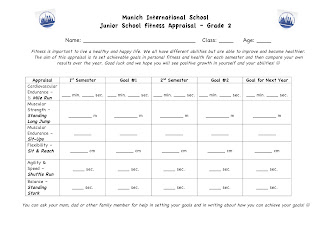So, I'm sure every PE teacher that blogs, blogs about Fitness Testing - How's it done? What's the purpose of it? Why do we do it? How can we manage time better in doing them? At what grade level do we begin fitness testing? ...and the list goes on. I guess I'll start by sharing how we do things at MIS:
This year, we changed our fitness tests to be named 'fitness appraisals' to try and eliminate some of the negative connotations related to the term that has been linked to PE since (probably) the middle ages. We also switched up the format of the test and took away one large, looming aspect - points. Previously, our fitness tests were run like the old-school American Presidential Fitness Tests where students received points based on their performances and then their points would be added up to place them in a Gold, Silver or Bronze ranking...or none at all as the case was for many students. I can understand how this would create stress for students in upper grades but some very unnecessary anxiety for younger students. Because of this, a lot of negative stigma has arisen from the term 'fitness testing'. +Jayson Bowerman
Of course, I understand that fitness testing (or appraising) is the least bit inquiry based and pretty far fetched from the PYP...but I still see the benefits of doing it. At MIS, students complete the fitness appraisals at the beginning of the academic year and then again just after the midway point of the year. Students set goals for themselves after the first round and then again before completing the fitness appraisals the second time around. Goals are then set again for the next year and papers are scanned and kept for reference the following year (well, that's the plan); the practice of setting goals, writing about how they can be achieved and then having students reflect on them is practical in PE as well as throughout the PYP so fitness appraising certainly offers a great platform for this. Students complete different tests (but some the same) in Grades 2-4 and then once they reach Grade 5 (which is now part of the MYP at MIS), they can choose what activities they complete to show their fitness in different areas and go around the gym completing them in groups of 2 or 3; from what I have seen, this works brilliantly! This eliminates so much of the 'wait time' which accompanies traditional fitness testing and more importantly, students aren't put on display for the entire class when completing a set of tasks
and they can keep their achievements private - I think this makes a huge
difference for middle and senior school students! This wait time and 'all eyes on you' factor still remain issues with our junior school classes.
Grade 4 students can work pretty well on their own and even more so once they know how the appraisals work and how to complete the listed activities. Grade 3 students can work a little more independently but still need guidance to stay on task and like the Grade 2s, there's a lot of wait time involved. Now that we've nearly wrapped up fitness appraisals for this academic year, we're reviewing the necessity of having Grade 2s do the activities. What age is an appropriate age to begin appraising fitness? At what age is having students get into the process of evaluating their cardiovascular endurance, muscular strength and endurance, flexibility, agility and speed as well as balance and reaction time fitting? The best thing that comes from these appraisals, is seeing students understand their progression (and very rarely regression) over the year, seeing the satisfaction they get when they achieve or surpass their goals and the overall enthusiasm (from 95% of the students) they put towards doing both of the above. By appraising fitness at a younger age, it prepares students for the inevitable appraising that takes place in the upper grades but, does this outweigh the negatives of playing the waiting game and the possibilities of damaging the self-confidence of those less physically able/confident? These are the questions we struggle with as we explore the option of omitting Grade 2s from the appraising and finding ways to get the Grade 3s to be more responsibly independent.
What are your thoughts on fitness appraisals and testing? Should it be done in schools? What are the pros and cons of this traditional practice in physical education classes?




No comments:
Post a Comment